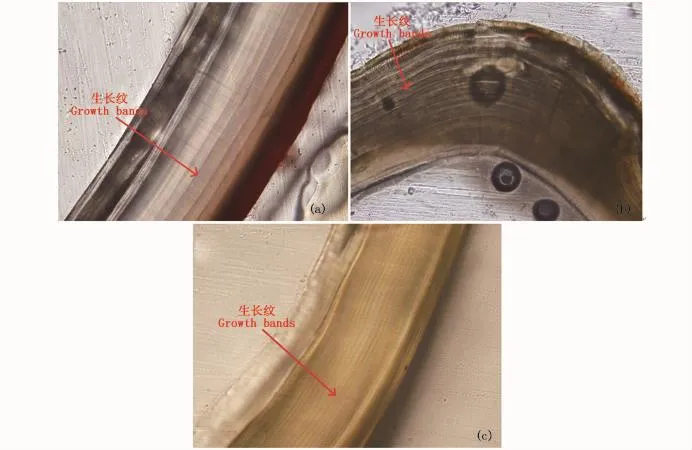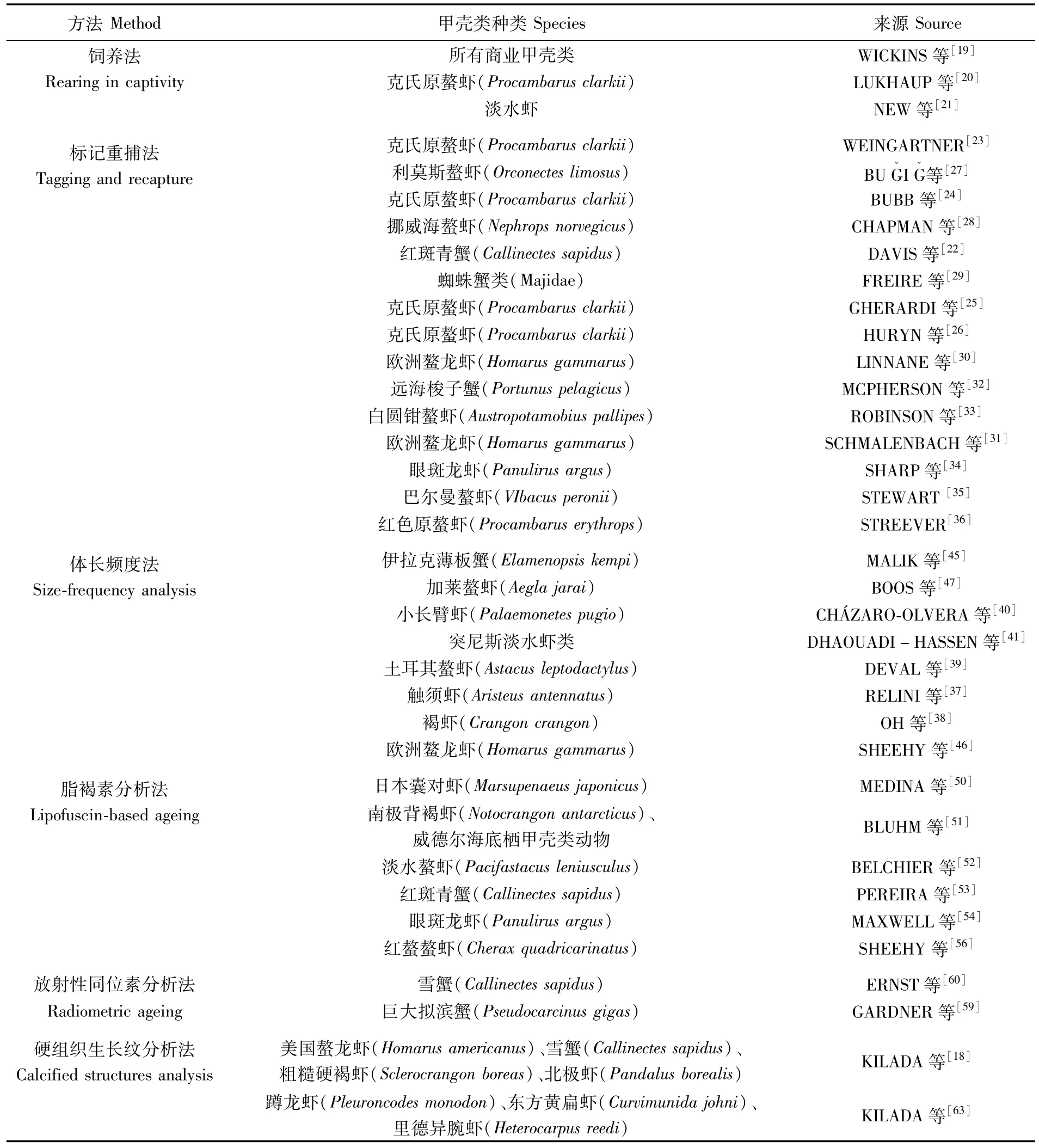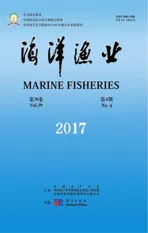甲壳类年龄鉴定方法研究进展
2017-09-04刘必林陈新军倪震宇林静远
蒋 瑞,刘必林,2,3,4,张 健,2,3,4,陈新军,2,3,4,倪震宇,林静远
·综述·
甲壳类年龄鉴定方法研究进展
蒋 瑞1,刘必林1,2,3,4,张 健1,2,3,4,陈新军1,2,3,4,倪震宇1,林静远1
(1.上海海洋大学海洋科学学院,上海 201306;2.国家远洋渔业工程技术研究中心,上海 201306;3.大洋渔业资源可持续开发省部共建教育部重点实验室,上海 201306;4.远洋渔业协同创新中心,上海 201306)
甲壳类特有的蜕壳现象,使其能够记录年龄信息的外骨骼周期性消失,因此甲壳类的年龄鉴定一直未得到较好的解决。年龄鉴定是评估甲壳类渔业资源的基础,鉴定甲壳类年龄的方法主要有饲养法、标记重捕法、体长频度法、脂褐素分析法、放射性同位素分析法和硬组织生长纹分析法。饲养法、标记重捕法和放射性同位素分析法较准确,然而由饲养法得到的数据不适用于实际野生环境,放射性同位素分析法花费较高,因此,这两种方法都存在较大的局限性。应用最广泛的标记重捕法和体长频度法也存在不足之处。相对于体长频度鉴龄技术而言,脂褐素分析法优势明显,但是对劳动强度和技术要求高。硬组织生长纹分析法是最近几年出现的鉴龄技术,也存在人为主观性较强等不足。本文对甲壳类年龄鉴定的方法进行了总结回顾,将不同鉴定方法进行比较,分析优缺点,以期为开展甲壳类资源评估与管理提供基础。
甲壳类;年龄与生长;年龄鉴定方法
甲壳类动物种类多、数量大,是渔业资源的重要组成部分[1],广泛分布于世界各大洋和南、北极等海域。年龄是研究水生动物生活史的必要组成部分[2],也是渔业种群动态模型及渔业资源评估中非常重要的参数之一。大多数水生动物能够通过计数硬组织中的生长纹来鉴定年龄,例如鱼类耳石[3-5]、鳍条[6-8]和脊椎骨[9-10],头足类耳石[11-12]、角质颚[13-14]和内壳[15-16]等。然而,甲壳类动物是脱壳式生长,每次脱壳时原先的硬壳被新壳替代,使其钙化结构周期性消失。因此,甲壳类的年龄鉴定一直未得到较好的解决[17],直到2012年KILADA等[18]首次发现甲壳类动物体内存在能够用来鉴定年龄的硬组织。本文归纳了现有甲壳类年龄鉴定的方法,并且对各方法进行了比较,以期为开展甲壳类年龄与生长的研究提供基础。
1 材料与方法
1.1 饲养法
实验室饲养法是甲壳类年龄鉴定最精确可靠的方法。WICKINS等[19]采用此方法对甲壳类的年龄进行了研究,并将结果记录于书中。LUKHAUP等[20]和NEW等[21]也运用此方法分别对养殖的克氏原螯虾(Procambarus clarkii)和淡水虾类的年龄进行了鉴定(表1)。
1.2 标记重捕法
标记重捕法是甲壳类另一个直接有效的鉴龄方法,作为研究动物生活史(如栖息地、死亡率、生长率、年龄等)和评价渔业资源并对其进行管理的重要工作内容,已经被广泛地应用在渔业资源研究中。采用标记重捕法,可以通过对标记生物个体或种群放流和重捕的时间、空间来分析和推测该生物移动的方向、速度、路线以及范围,并可以依据标记生物体长、重量和年龄的变化推测其在放流场所的生长率,进而为评估渔业资源现状提供资料和依据。为了确保标记的保留时间,标记通常被放置在甲壳类甲壳之下。常用的标记有被动整合雷达标记(passive integraded transpoder,PIT)、微编码线标记(code wire tag,CWT)、可视植入字母数字标记和可视植入弹性体等。
可视植入字母数字标记和可视植入弹性体要求从外部可以直接读取信息,所以通常需要放置在透明的甲壳类甲壳之下。然而,当甲壳类的外壳钙化加厚之后,可读性通常会变差[22],所以,相比之下,CWT和PIT更适合于标记重捕法的甲壳类年龄鉴定中。
WEINGARTNER[23]于1981年第一次将标记重捕法运用于克氏原螯虾的年龄鉴定中,随后BUBB等[24]、GHERARDI等[25]、HURYN等[26]在研究克氏原螯虾时同样用了该方法。众多实验中表明,标记重捕法同样适用于利莫斯螯虾(Orconectes limosus)[27]、挪威海螯虾(Nephrops norvegicus)[28]、红斑青蟹(Callinectes sapidus)[22]、蜘蛛蟹类(Majidae)[29]、欧洲鳌龙虾(Homarus gammarus)[30-31]、远海梭子蟹(Portunus pelagicus)[32]、白圆钳螯虾(Austropotamobius pallipes)[33]、眼斑龙虾(Panulirus argus)[34]、巴尔曼螯虾(Ibacus peronii)[35]和红色原螯虾(Procambarus erythrops)[36]。
1.3 体长频度法
体长频度法是早期学者鉴定甲壳类年龄的最常采用方法[37-41]。对于那些不能通过硬组织生长纹鉴定年龄的水生生物,该方法是另外一个最佳选择[42-43]。体长频度法首先将体长数据分成不同的体长组,然后用Von Bertalanffy生长方程或其他模型将其转换成年龄组[43]。ANDRADE等[44]已经开发了一些软件包(ELEPHANT、MULTIFAN),用于从长度频率数据估算生长参数和年龄组成。
早前,MALIK等[45]于1995使用体长频度法对伊拉克巴士拉河流中伊拉克薄板蟹(Elamenopsis kempi)的种群动力学进行研究,随后,RELINI等[37]发现成年雌性触须虾(Aristeus antennatus)的年龄能达到17岁。1999年,OH等[38]同样使用体长频度法研究褐虾(Crangon crangon)的种群动力,SHEEHY等[46]认为在鉴定欧洲鳌龙虾寿命和生长时使用体长频度法是一种新的趋势。体长频度法在研究加莱螯虾(Aegla jarai)[47]、小长臂虾(Palaemonetes pugio)[40]、突尼斯境内的淡水虾类[41]和土耳其螯虾(Astacus leptodactylus)[39]时都取得了较好的结果。
1.4 脂褐素分析法
脂褐素是细胞内与衰老相关的色素颗粒,最初由HANNOVER[48]于1842年发现并报道,如今已被认为是细胞中最明显的年龄标记[49]。现在已有的研究证明,部分甲壳类生物其脂褐素浓度会随着年龄的增长而增加(表1),如日本囊对虾(Marsupenaeus japonicus)[50]、南极背褐虾(Notocrangon antarcticus)[51]、淡水螯虾(Pacifastacus leniusculus)[52]、欧洲鳌龙虾[46]、红斑青蟹[53]、眼斑龙虾[54]。在无法建立形态特征与年龄之间的关系时,脂褐素分析法可以作为许多无脊椎动物鉴龄研究中的年龄生长标记[51,54-57]。相对于体长或体重法鉴龄技术而言,该方法优势明显[52,58]。
1.5 放射性同位素分析法
放射性同位素分析法适用于确定甲壳类外壳年龄,进而反映自上一次蜕壳后经过的时间。在蜕壳后,同位素228Ra进入外壳,经过一定的时间衰变成为228Th。每个元素的半衰期是已知的,因此可以通过这两种元素的比率来确定所经历的时间[59-60]。
1.6 硬组织生长纹分析法
硬组织生长纹分析法是近几年兴起、用于甲壳类鉴定年龄的新方法,之前最常用于鱼类(鳞片[61-62]、鳍条[6-8]、脊椎骨[9-10]和耳石[3-5])和头足类(角质颚[13-14]、内壳[15-16]和耳石[11-12])。2012年,KILADA等[18]首次对美国螯龙虾(Homarus americanus),雪蟹(Chionoecetes opilio),粗糙硬褐虾(Sclerocrangon boreas)和北极虾(Pandalus borealis)眼柄或胃磨中的生长纹进行研究,研究首先将眼柄或胃磨制成切片,然后在显微镜计数生长纹的数目,并与实际年龄做比较,结果发现生长纹个数与样品实际寿命基本相符,因此该方法为甲壳类提供了一种直接准确的年龄鉴定方法。随后,2015年KILADA等[63]使用胃磨对智利的蹲龙虾(Pleuroncodesmonodon)、东方黄扁虾(Cervimunida johni)和里德异腕虾(Heterocarpus reedi)三种重要商业价值的甲壳类进行鉴龄。目前,我们在此基础上对中华绒螯蟹(Eriocheir sinensis)、三疣梭子蟹(Portunus trituberculatus)和中国明对虾(Penaeus orientalis)眼柄的生长纹进行了观察与分析(图1)。从图1中,可以清楚地看到眼柄中的生长纹。
2 年龄鉴定方法的比较分析
与野外环境不同,实验室饲养法只是在适宜物种生存的环境中得到数据,因此,饲养法得到的数据只能用于水产养殖或者构建实验室模型中,不能用于野生环境中生存生长物种的年龄鉴定。相比于饲养法,标记重捕法将样品标记后放流,更贴合实际情况,但是该方法实验周期长,耗费的时间、精力和金钱较多,且对于定期蜕壳的甲壳类物种来说,标记容易破损、丢失,且个体重捕率低。所以,饲养法和标记重捕法虽然得到的结果比较直接,但在甲壳类鉴龄中不常用。
体长频度法是甲壳类年龄鉴定中最常见的方法,其数据收集起来较简单迅速。然而,当研究的物种年龄越大时,体长频度法得到的结果偏差越大,年龄逐渐增大,体长增长率变小,年龄大的、生长缓慢的样品可能会与年龄小的、生长迅速的样品分为一组,导致最后得到的结果不准确。因此,体长频度法不适宜于寿命长的甲壳类[46,64]。此外,基于长度-频度模型要求附加的数据或假设的输入,因此,可能会出现不同的输出结果[64]。体长频度法依赖于确定样本的体长模态,理想情况下,模态可以清楚地予以定义,体长频度分布也呈正态分布,分析相对简单直接。然而,实际情况并非如此,体长分布数据的解释通常易受人为错误干扰[64]。

图1 (a)三疣梭子蟹眼柄中的生长纹;(b)中华绒螯蟹眼柄中的生长纹;(c)中国明对虾眼柄中的生长纹Fig.1 The grow th bands of eyestalk of(a)Portunus trituberculatus,(b)Eriocheir sinensis and(c)Penaeus orientalis

表1 甲壳类年龄鉴定方法Tab.1 M ethods for the crustaceans age identification
脂褐素分析法不易受到人为因素的影响,但是脂褐素每年的平均累积速率不同,这取决于该物种的代谢速率。例如,红螯螯虾(Cherax quadricarinatus)、淡水螯虾、欧洲鳌龙虾和南极背褐虾的每年的脂褐素含量百分比分别为2.0%、0.20%、0.07%和0.02%[51,65]。脂褐素含量是物种生理年龄的标记而不是实际年龄的标记,这需要利用已知年龄的样品对物种和环境进行校准[54,58]。脂褐素分析法的缺点是对劳动强度和技术要求高,在应用于野生种群之前需要构建物种特异性数据库。脂褐素鉴龄研究因量化和校准技术存在的困难和不确定性而发展缓慢[18]。因此,这种方法不适合在渔业管理中使用。
放射性同位素分析法得到的结果也比较准确,由于元素的半衰期一般较长,所以该方法一般适用于寿命较长的物种,花费较高,测量元素半衰期时要求特殊的实验设备。所以,该方法在甲壳类年龄鉴定的中的应用相对较少。
硬组织生长纹分析法利用甲壳类眼柄或胃磨等硬组织在生长过程中产生的生长纹来鉴定年龄,利用生长纹鉴定甲壳类年龄是最为精确的方法,硬组织也易于提取。硬组织生长纹分析法对于甲壳类鉴龄研究来说,为直接鉴定甲壳类年龄提供了一个新方法,应用前景广泛。
3 分析与展望
到目前为止还没有确定哪一种方法是最有效的独立鉴定甲壳类年龄的方法,对于不同种类的甲壳类或者同一种类的不同年龄阶段,最佳鉴龄方法也可能不一致,要对比多种鉴龄方法予以确定。对同一种甲壳类进行年龄鉴定的时候,可以采取多种年龄鉴定方法相结合,相互交叉比较,既可以比较得出此类甲壳类各年龄最适合的年龄鉴定方法,也能相互验证不同方法,进而比较得出各年龄段最适宜的年龄鉴定方法,最终精确鉴定出年龄。
在实际的生产实践中,饲养法得到的数据适用于水产养殖或者构建实验室模型中,标记重捕法适合对洄游区域小的甲壳类鉴龄,体长频度法在分析生长迅速的甲壳类时比较理想,在有校准技术保证的前提下比较适合使用脂褐素分析法对甲壳类进行鉴龄,对寿命长的甲壳类鉴龄时,放射性同位素分析法比较适宜。
硬组织生长纹分析法通过直接读取甲壳类硬组织中的生长纹数目来鉴定其年龄,该方法的出现很好地解决了缺乏直接有效甲壳类鉴龄方法的问题,进而为甲壳类渔业资源评估与管理提供理论基础。在今后对甲壳类年龄生长的研究中,硬组织生长纹分析法的精确性和广泛的应用前景使该方法成为主流的甲壳类鉴龄方法。应当注意的是,在使用时需要改进以下几点:(1)选取合适的实验材料(眼柄或者胃磨)、正确的截面,以及掌握熟练的切面研磨技术;(2)多次多人对生长纹进行读取,各研究者之间加强相互交流;(3)利用微结构对年龄进行进一步研究;(4)使用其他方法进行交叉验证;(5)建立以甲壳类年龄与生长为基础的数据库,包括甲长、甲宽、体重的范围、性别和性腺等级的数据参考标准,利用数据库为甲壳类年龄鉴定提供参考。硬组织生长纹分析法虽然是最近几年才出现的新方法,但相比其他方法来说相对精确,如果能够避免该方法的缺点,该方法的发展潜力比较大,能更好地对甲壳类年龄生长进行研究。
[1] 刘瑞玉.南海对虾类[M].北京:农业出版社,1988.LIU R Y.Economic shrimp and crab in North of China[M].Beijing:Science Press,1988.
[2] CASSIDY K M.Use of extractable lipofuscin as an age biomarker to determine age structure of ghost shrimp(Neotrypaea californiensis)populations in west coast estuaries[J].Explorer Site-North Coast Explorer,2008.
[3] 张治国,王卫民.鱼类耳石研究综述[J].湛江海洋大学学报,2001,21(4):77-83.DOI:10:13140/RG.2.1.3453.7681.
ZHANG Z G,WANG W M.A Review of Fish Otolith Research[J].Journal of Zhanjiang Ocean University,2001,21(4):77-83.DOI:10:13140/RG.2.1.3453.7681.
[4] 裘海雅,徐东坡,施炜纲.鱼类耳石与年龄关系的研究进展[J].浙江海洋学院学报(自然科学版),2009,28(3):331-337.
QIU H Y,XU D P,SHIW G.A review of the relationship between fish otolish and age[J].Journal of Zhejiang Ocean University(Natural Science),2009,28(3):331-337.
[5] KALISH JM.Otolith microchemistry:Validation of the effects of physiology,age and environment on otolith composition[J].Journal of Experimental Marine Biology&Ecology,1989,132(3):151-178.
[6] 熊 飞,陈大庆,刘绍平,等.青海湖裸鲤不同年龄鉴定材料的年轮特征[J].水生生物学报,2006,30(2):185-191.
XIONG F,CHEN D Q,LIU S P,et al.Annuli characteristics of the different ageingmaterials of Gymnocypris przewalskii przewalskii(kessler)[J].Acta Hydrobiologica Sinica,2006,30(2):185-191.
[7] 陈焜慈,邬国民,李恒颂.珠江斑鳠年龄和生长的研究[J].中国水产科学,1999,6(4):63-67.
CHEN K C,WU G M,LIH S.Studies on the age and growth of Mystusguttatus[J].Journal of Fishery Sciences of China,1999,6(4):63-67.
[8] KOCH JD,QUISTM C.A technique for preparingfin rays and spines for age and growth analysis[J].North American Journal of Fisheries Management,2007,27(3):782-784.
[9] 谢小军.嘉陵江南方大口鲶的年龄和生长的初步研究[J].生态学报,1987,7(4):73-81.
XIE X J.A study on the age and growth of silurus soldatovimeridionalis in the jialing river[J].Acta Ecologica Sinica,1987,7(4):73-81.
[10] 江建军,许柳雄,朱国平,等.北太平洋长鳍金枪鱼年龄与生长初步研究[J].海洋渔业,2016,38(1):1-8.
JIANG JJ,XU L X,ZHU G P,et al.Preliminary study on age and growth of north Pacific albacore Thunnus alalunga[J].Marine Fisheries,2016,38(1):1-8.
[11] 马 金,刘必林,陈新军,等.利用耳石鉴定头足类年龄与生长研究进展[J].海洋渔业,2009,31(3):316-324.
MA J,LIU B L,CHEN X J,et al.Advances on using sta tolith to study age and growth of cephalopod[J].Marine Fisheries,2009,31(3):316-324.
[12] 刘必林.利用耳石微结构研究印度洋西北海域鸢乌贼的年龄和生长[D].上海:上海水产大学,2006.
LIU B L.Studying age and growth of purple back flying squid(Sthenoeuthis oualaniensis)in northwest India Ocean based on statolith microstructure[D].Shanghai Ocean University,2006.
[13] 刘必林,陈新军,方 舟,等.利用角质颚研究头足类的年龄与生长[J].上海海洋大学学报,2014,23(6):930-936.
LIU B L,CHEN X J,FANG Z,et al.Study of age and growth of cephalopod using their beaks[J].Journal of Shanghai Ocean University,2014,23(6):930-936.
[14] 胡贯宇,陈新军,刘必林,等.茎柔鱼耳石和角质颚微结构及轮纹判读[J].水产学报,2015,39(3):361-370.
HU G Y,CHEN X J,LIU B L,et al.Microstructure of statolith and beak for Dosidicus gigas and its determination of growth increments[J].Journal of Fisheries of China,2015,39(3):361-370.
[15] 刘必林,陈新军,李建华.内壳在头足类年龄与生长研究中的应用进展[J].海洋渔业,2015,37(1):68-76.
LIU B L,CHEN X J,LIJH.Advances on age and growth of cephalopods by using gladius,stylets and cuttlebone[J].Marine Fisheries,2015,37(1):68-76.
[16] 刘必林,陈新军.头足类贝壳研究进展[J].海洋渔业,2010,32(3):332-339.
LIU B L,CHEN X J.Research progress on shells in Cephalopods[J].Marine Fisheries,2010,32(3):332-339.
[17] 朱国平,宋 旗.运用脂褐素鉴定甲壳类年龄的研究进展[J].生态学杂志,2016,35(8):2225-2233.
ZHU G P,SONG Q.Aging crustacean based on the lipofuscin analysis:A review[J].Chinese Journal of Ecology,2016,35(8):2225-2233.
[18] KILADA R,SAINTE-MARIE B,ROCHETTE R,et al.Direct determination of age in shrimps,crabs,and lobsters[J].Canadian Journal of Fisheries&Aquatic Sciences,2012,69(11):1728-1733.
[19] WICKINS J F,LEE D O.Crustacean farming:Ranching and culture,second edition[M].2007.
[20] LUKHAUP C,LUKHAUP C.Süβwasserkrebse aus aller welt[M].Daehne Verlag,2008.
[21] NEW M B,VALENTIW C,TIDWELL JH,et al.Freshwater Prawns:Biology and Farming[M].2009.
[22] DAVIS J L D,YOUNG-WILLIAMS A C,HINES A H,et al.Comparing two types of internal tags in juvenile blue crabs[J].Fisheries Research,2004,67(3):265-274.
[23] WEINGARTNER D L.A field-tested internal tag for crayfish(decapoda,astacidea)[J].Crustaceana,1981,43(2):181-188.
[24] BUBB D H,LUCASM C,THOM T J,et al.The potential use of pit telemetry for identifying and tracking crayfish in their natural environment[J].Hydrobiologia,2002,483(1):225-230.
[25] GHERARDI F,BARBARESIS,SALVIG.Spatial and temporal patterns in the movement of Procambarus clarkii,an invasive crayfish[J].Aquatic Sciences,2000,62(2):179-193.
[26] HURYN A D,VENARSKY M P,KUHJADA B J,et al.Assessment of population size,age structure and growth rates for cave inhabiting crayfish in alabama[R].Montgomery,Departmentof Conservation and Natural Resources,2008.
[27] BU RˇICˇM,KOZÁK P,VÍCH P.Evaluation of different marking methods for spiny-cheek crayfish(Orconectes limosus)[J].Knowledge&Management of Aquatic Ecosystems,2008,389(389):198-201.
[28] CHAPMAN C J,SHELTON P M J,SHANKSA M,et al.Survival and growth of the norway lobster nephrops norvegicus in relation to light-induced eye damage[J].Marine Biology,2000,136(2):233-241.
[29] FREIRE J,GONZÁLEZ-GURRIARÁN E.New approaches to the behavioural ecology of decapod crustaceans using telemetry and electronic tags[J].Hydrobiologia,1998(371-372):123-132.
[30] LINNANE A,MERCER JP.A comparison ofmethods for tagging juvenile lobsters(Homarus gammarus L.)reared for stock enhancement[J].Aquaculture,1998,163(3-4):195-202.
[31] SCHMALENBACH I,MEHRTENSF,JANKEM,et al.A mark-recapture study of hatchery-reared juvenile european lobsters,Homarus gammarus,released at the rocky island of helgoland(german bight,north sea)from 2000 to 2009[J].Fisheries Research,2011,108(1):22-30.
[32] MCPHERSON R.Assessmentof t bar anchor tags for marking the blue swimmer crab portunus pelagicus(L.)[J].Fisheries Research,2002,54(54):209-216.
[33] ROBINSON CA,THOM T J,LUCASM C.Ranging behaviour of a large freshwater invertebrate,the white-clawed crayfish austropotamobius pallipes[J].Freshwater Biology,2000,44(3):509-521.
[34] SHARPW C,LELLISW A,BUTLER M J,et al.The use of coded microwire tags in mark-recapture studies of juvenile caribbean spiny lobster,Panulirus argus[J].Journal of Crustacean Biology,2000,20(3):510-521.
[35] STEWART J.Long-term recaptures of tagged scyllarid lobsters(Ibacus peronii)from the east coast of australia[J].Fisheries Research,2003,63(2):261-264.
[36] STREEVER W J.Energy economy hypothesis and the troglobitic crayfish[J].American Midland Naturalist,1996,135(2):357-366.
[37] RELINI L O,RELINIG.Seventeen instars of adult life in female Aristeus antennatus(crustacea:Decapoda:Aristeidae).A new interpretation of life span and growth[J].Journal of Natural History,1998,32(10-11):1719-1734.
[38] OH C W,HARTNOLL R G,NASH R D M.Population dynamics of the common shrimp, Crangon crangon(L.),in port erin bay,isle of man,irish sea[J].ICESJournal ofMarine Science,1999,56(5):718-733.
[39] DEVALM C,TOSUNOGˇLU Z.Length-based estimates of growth parameters,mortality rates,and recruitment of Astacus leptodactylus(eschscholtz,1823)(decapoda,astacidae)in unexploited inland waters of the northern marmara region,european turkey[J].Crustaceana,2007,80(6):655-665.
[40] CHÁZAROOLVERA S.Growth,mortality,and fecundity of palaemonetes pugio from a lagoon system inlet in the southwestern gulf of Mexico[J].Journal of Crustacean Biology,2009,29(2):201-207.
[41] DHAOUADI-HASSEN S,BOUMAÏZA M.Reproduction and population dynamics of Atyaephyra desmarestii(decapoda,caridea)from the sidi salem dam lake(northern tunisia)[J].Crustaceana,2009,82(2):129-139.
[42] PAULY D,MORGAN G R.Length-based methods in fisheries research[J].ICLARM Conference Proceedings,1987(13):468.
[43] JENNINGS S,KAISER M J,REYNOLDS J D.Marine Fisheries Ecology[M].Blackwell Publishing,2001.
[44] ANDRADE H A,KINASPG.Estimation of birthdates and catch-at-age using length frequency analysis(lfa),with application for skipjack tuna(Katsuwonus pelamis)caught in the southwest atlantic[J].ICESJournal ofMarine Science,2004,61(5):798-811.
[45] MALIK H A,SALMAN M D,AL-ADHUB A Y.Population dynamics of the hymenosomatid crab elamnopsis kempi in a brackish subtidal region of Basrah,Iraq[J].Scientia Marina,1995(59):1-13.
[46] SHEEHY M,BANNISTER R,WICKINS JF,et al.New perspectives on the growth and longevity of the european lobster[J].Canadian Journal of Fisheries&Aquatic Sciences,1999,56(56):1904-1915.
[47] BOOS JH,SILVA-CASTIGLIONID,SCHACHT K,et al.Crescimento de aegla jarai bond-buckup&buckup(crustacea,anomura,aeglidae)[J].Revista Brasileira De Zoologia,2006,23(2):490-496.
[48] HANNOVER A.Mikroskopiske undersögelser af neresysteme[J].Kgl Danbske Videsk Kabernes Selkobs naturv Math Aft Copenhagen,1842(10):1-112.
[49] HALLIWELL B,GUTTERIDGE JM.Oxygen toxicity,oxygen radicals,transition metals and disease[J].Biochemical Journal,1984,219(1):1-14.
[50] MEDINA A,VILA Y,MEGINA C,et al.A histological study of the age-pigment,lipofuscin,in dendrobranchiate shrimp brains[J].Journal of Crustacean Biology,2000,20(3):423-430.
[51] BLUHM B A,BREY T.Age determination in the antarctic shrimp notocrangon antarcticus(crustacea:Decapoda),using the autofluorescent pigment lipofuscin[J].Marine Biology,2001,138(2):247-257.
[52] BELCHIER M,EDSMAN L,SHEEHY M R J,et al.Estimating age and growth in long-lived temperate freshwater crayfish using lipofuscin[J].Freshwater Biology,1998,39(3):439-446.
[53] PEREIRA C R,D’INCAO F,FONSECA D B.Bilateral comparison of in situ neurolipofuscin accumulation in Callinectes sapidus caught in thewild[J].Journal of the Marine Biological Association of the United Kingdom,2010,90(3):563-567.
[54] MAXWELL K E,MATTHEWS T R,SHEEHY M R,et al.Neurolipofuscin is a measure of age in Panulirus argus,the caribbean spiny lobster,in florida[J].Biological Bulletin,2007,213(1):55-66.
[55] ETTERSHANK G,MACDONNELL I,CROFT R.The accumulation of age pigment by the fleshfly,sarcophaga bullata parker(diptera:Sarcophagidae)[J].Australian Journal of Zoology,1983,31(2):131-138.
[56] SHEEHY M,CAPUTIN,CHUBB C,et al.Use of lipofuscin for resolving cohorts ofwestern rock lobster panul[J].Canadian Journal of Fisheries&Aquatic Sciences,2011,55(4):925-936.
[57] KODAMA K,SHIRAISHIH,MORITA M,et al.Verification of lipofuscin-based crustacean ageing:Seasonality of lipofuscin accumulation in the stomatopod Oratosquilla oratoria in relation to water temperature[J].Marine Biology,2006,150(1):131-140.
[58] SHEEHY M R J,GREENWOOD JG,FIELDER D R.More accurate chronological age determination of crustaceans from field situations using the physiological age marker,lipofuscin[J].Marine Biology,1994,121(2):237-245.
[59] GARDNERC,JENKINSONA,HEIJNISH.Estimating intermoult duration in giant crabs Pseudocarcinus gigas[J].Agricultural&Veterinary Sciences,2002:17-28.
[60] ERNST B,ORENSANZ JM,ARMSTRONG D A.Spatial dynamics of female snow crab(Chionoecetes opilio)in the eastern bering sea[J].Canadian Journal of Fisheries&Aquatic Sciences,2005,62(62):250-268.
[61] 吴万荣.布氏哲罗鲑年龄与生长的初步研究[J].水产学报,1987,11(1):37-44.
WUW R.On the age and growth of Hucho bleekeri kimura[J].Journal of Fisheries of China,1987,11(1):37-44.
[62] 王继隆,唐富江,刘 伟.大麻哈鱼的年龄与生长[J].水生生物学报,2012,36(6):1149-1155.
WANG JL,TANG F J,LIUW.Age and growth of chum salmon[J].Acta Hydrobiologica Sinica,2012,36(6):1149-1155.
[63] KILADA R,ACUÑA E.Direct age determination by growth band counts of three commercially important crustacean species in chile[J].Fisheries Research,2015(170):134-143.
[64] HARTNOLL R G.Growth in crustacea—twenty years on[M].Netherlands:Springer,2001.
[65] SHEEHY M R.Role of environmental temperature in aging and longevity:Insights from neurolipofuscin[J].Archives of Gerontology&Geriatrics,2002,34(3):287-310.
Advance on methods for the age identification of crustaceans
JIANG Rui1,LIU Bi-lin1,2,3,4,ZHANG Jian1,2,3,4,CHEN Xin-jun1,2,3,4,NIZhen-Yu1,LIN Jing-yuan1
(1.College of Marine Sciences,Shanghai Ocean University,Shanghai201306,China;2.National Distant-water Fisheries Engineering Research Center,ShanghaiOcean University,Shanghai 201306,China;3.The Key Laboratory of Sustainable Exploitation of Oceanic Fisheries Resources,Ministry of Education,ShanghaiOcean University,Shanghai 201306,China;4.Collaborative Innovation Center for Distant-water Fisheries,Shanghai 201306)
Crustaceans are widely distributed in the oceans worldwide including the polar region.Their high species diversity and large quantity make them become an important part of fishery resources.Age is the essential part of the aquatic animal life history study,as well as one of themost important parameters in the fish population dynamicsmodels and fishery resources evaluation.Mostaquatic animals’age can be identified by counting the growth bands in the hard tissue.However,crustaceans grow up through molt,leading to the original shells replaced by the new ones,which causes the periodic record of their calcified structures disappearing.Therefore,the age identification of crustaceans has never been perfectly accomplished.Main existingmethods for the crustaceans’age identification are rearing in captivity,tagging and recapture,sizefrequency analysis,lipofuscin-based ageing,radioisotope analysis and calcified structures analysis.Rearing in captivity is the most accurate and reliable method for the crustaceans’age identification.Tagging and recapturemethod ismore directand effective.Size-frequency analysismethod ismost commonly used by early scholars.In thismethod,crustaceans’body length data are firstly classified into different body length groups,and then converted into age groups by Von Bertalanffy growth equation or other equation models.For the relationship between the morphological characteristics of crustaceans and their ages can not be established,lipofuscin-based ageingmethod is applied for the age identification ofmany invertebrates.Lipofuscin is related with cells aging,which is one of themost obvious age tags in cells.Radiometric ageingmethod is applicable to determine the crustaceans’shell age and the results are also comparatively accurate.This method is generally used for long-lived species based on the long elementhalf-life,but the elementhalf-lifemeasuremeat requires special equipment so the cost for thismethod is very high.So it is less used.Calcified structures analysis is a kind ofmethod to count the growth bands that generate in the crustaceans’eye stalk or gastric when they grow.Calcified structures analysis is themost accuratemethod,and the needed hard tissue is easy to extract.The calcified structure analysis method provides a new way for the direct age identification of crustaceans,and its application prospect is extensive.Rearing in captivity method,tagging and recapture method and radiometric ageing method all are comparatively accurate.However,the data obtained from the rearing in captivity method is not applicable in the natural environment,and the radiometric ageingmethod is very expensive.So both methods have limitations in practice.The tagging and recapture method and sizefrequency analysis method which are most widely used also have their disadvantages.Compared to sizefrequency analysismethod,lipofuscin-based ageing method has obvious advantages,but the labor intensity and technical requirements are high.Calcified structures analysismethod is the age identification technology that has appeared in recent years,and the age is identified by directly counting the number of growth bands in crustaceans’hard tissue.Thismethod is a good solution to the lack of direct and effective crustaceans’age identification,and provides the theoretical basis for the assessment and management of crustacean fishery resources,but there are also some disadvantages like strong man-made subjectivity.In this paper,themethods of crustaceans’age identification are reviewed and summarized,the differentmethods are compared and analyzed to get the advantages and disadvantages,so as to provide the basis for the assessment and management of crustacean fishery resources.
crustaceans;age and growth;age determination methods
S 931
A
1004-2490(2017)04-0471-10
2016-12-21
国家自然科学基金(NFSC41306127,NSFC41276156);上海市自然科学基金(13ZR1419700);教育部博士点基金(20133104120001)
蒋 瑞(1994-),女,硕士研究生,主要从事渔业资源学研究。
刘必林,副教授。E-mail:bl-liu@shou.edu.cn
